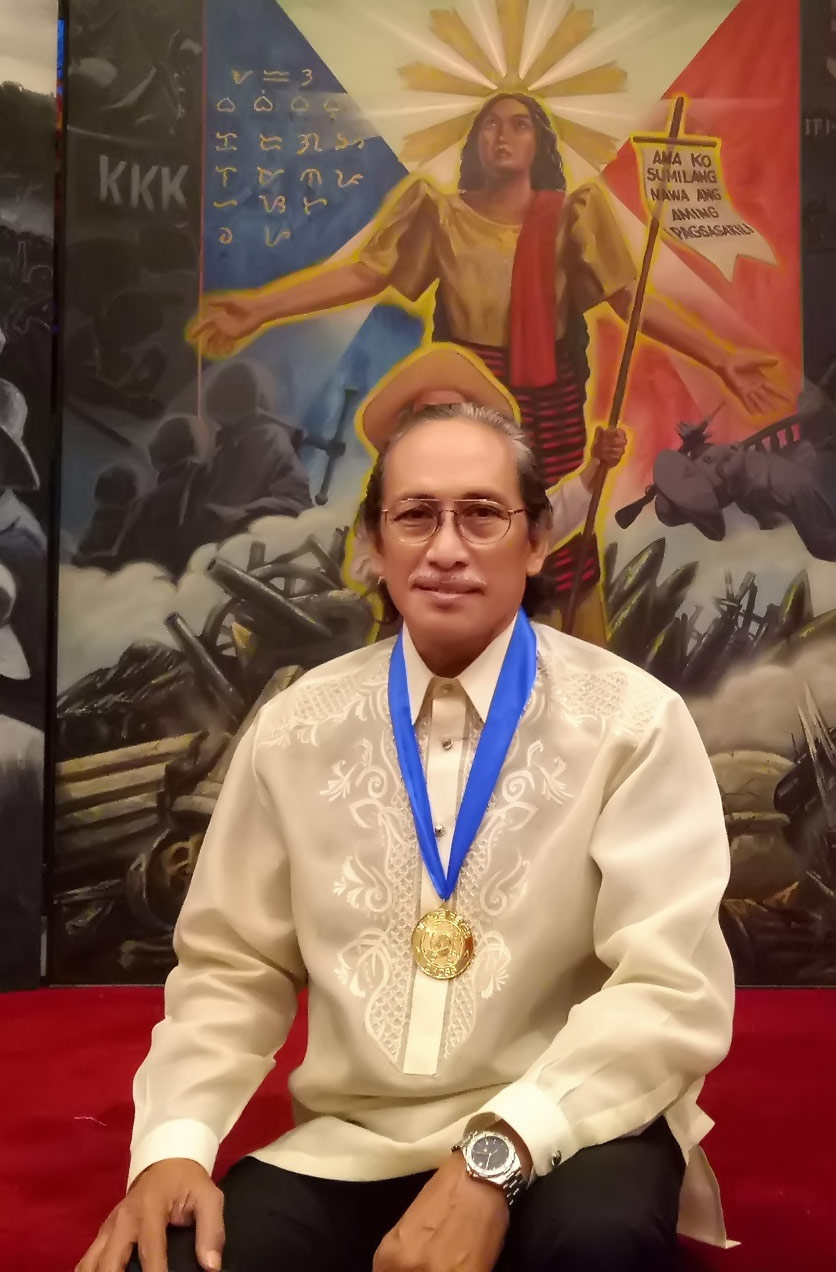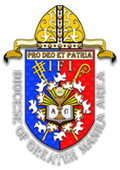Egai Fernandez: Painter of Birhen Balintawak
 The painting of “Birhen Balintawak” with the young (child) katipunero is shown in many of the IFI publications such as souvenir programs, postcards, calendars and diaries/planners, and provided the background of the IFI centennial celebration at the Quirino Grandstand in Luneta on August 2-3, 2002. But in the various uses of this original painting, no acknowledgment has ever been made about the painter behind this classic image depicting the Filipinos’ aspirations for nationalism and religious reformation. In line with his own nationalist sentiment, Edgar (“Egai”) Talusan Fernandez accepted this artistic commissioning based on his interpretation of Bishop Gregorio Aglipay’s “Novenario” and the Katipunan event narrative, illustrating the nationalist struggles which served as the backdrop for the formation of Philippine nationhood and the organization of the IFI.
The painting of “Birhen Balintawak” with the young (child) katipunero is shown in many of the IFI publications such as souvenir programs, postcards, calendars and diaries/planners, and provided the background of the IFI centennial celebration at the Quirino Grandstand in Luneta on August 2-3, 2002. But in the various uses of this original painting, no acknowledgment has ever been made about the painter behind this classic image depicting the Filipinos’ aspirations for nationalism and religious reformation. In line with his own nationalist sentiment, Edgar (“Egai”) Talusan Fernandez accepted this artistic commissioning based on his interpretation of Bishop Gregorio Aglipay’s “Novenario” and the Katipunan event narrative, illustrating the nationalist struggles which served as the backdrop for the formation of Philippine nationhood and the organization of the IFI.
Multi-awarded and internationally-known painter, sculptor and print artist, Egai does not only paint with his brushes in vibrant colors but also depicts his vicarious struggle with his people in their powerlessness, oppression, marginalization and exploitation. This very same struggle that the IFI continues in its prophetic journey since the 1896 revolution has found creative (visual) expressions in Egai’s socially contextualized themes, including the IFI’s “Birhen Balintawak”. The Mother-and-Child theme in many of his nationalist works symbolizes the relationship between a nurturing Motherland and a vulnerable (growing) child/youthful citizenry embued with courageous hope, seeds of change, or renewed vitality.
Barely 12 years old – akin to Jose Rizal’s tender age of awareness – Egai’s profound nationalist spirit found roots at the beginning of the worldwide student unrest movement during the mid- sixties. Joining the SR (Social Realist) Movement which used the brush-canvass medium to portray the Third-World injustices such as militarization, poverty, human rights violations, etc., Egai’s visual arts now focused on nationalist intentions after abandoning his abstract paintings which built his reputation. Armed with reflections on Philippine history and the socio-economic- political upheavals arising from the Marcos dictatorship, his paintings now changed dimension to encompass images of events and symbols creating national consciousness but permeating visions of hope, self-reliance and freedom.
No other artist has projected on canvass this Filipino nationalist sentiment and the revolutionary and prophetic sentiment of the Iglesia Filipina Independiente than Egai himself. As a social watchman, he recorded Philippine historical and social realities in colorful spatial tableaux, and like the prophet Isaiah, his powerful brushes also projected pictures of either glimmering hope or glorious splendor amidst the pathetic chaos and gloomy atrocities, as exemplified in the portraiture of the Birhen Balintawak.
His aesthetic sense and sensibility are inspired gifts to one destined to play a great artistic and prophetic role. As early as three years of age, Egai’s talent became evident with his first sketch of a horse-drawn calesa complete with wheels and other details in the correct perspective. His mother, recognizing her son’s extraordinary talent, enrolled in Fine Arts at the University of the Philippines to properly guide her artistic son and to expose him to the works of the famous artist Abueva. He received his first artistic award when his painting was sent to India and won in an international children’s painting competition.
Egai’s “living faith” on canvass is a reflection of his happy childhood as the son of Ester de los Santos Talusan of Bulacan and Eliodoro Marte Fernandez of Aklan. Growing up in Makati, he became exposed to the Bible and served as altar boy (acolyte) in the Catholic Church. His public vocational education at the Araullo High School (Manila) climaxing in 1970 and artistic preparation at the College of Music and Fine Arts of the Philippine Women’s University (1971- 1975) are mute backgrounds to his creative grandeur respected by art colleagues and afficionados locally and internationally. With his contributions to solo and group art exhibitions gaining worldwide acclaim, they did not only merit prestigious awards (first and grand prizes) but also found themselves in the art collections of connoisseurs and major corporations. But dear in the hearts of his fellow countrymen are the true works of his heart, i.e., those depicting their nationalist struggles and aspirations.
Egai’s personal monument in the art world is further enhanced by his offspring’s grateful expression of filial tribute. Malaya and Diwa (Egai’s children), each, separately and freely chose to follow in their father’s footsteps by both majoring in fine arts and finding gainful employment in the same field. Finding fulfillment in his career and family life (married to Nena Baetiong Gajudo of Balintawak, Quezon City), it is no wonder that a well-accomplished artist with a balanced life and simple lifestyle is inspired to produce majestic works of art with deep spiritual insights and profound nationalistic sentiments. Creating a social awareness on his canvass that is not too easily discernible on first inspection and impression but upon closer scrutiny emerges one’s growing zealous introspection, his self-descriptions of his paintings are “Makabayan” and “Makabuluhan”. Nationalist, environmentalist, humanist, ecumenist, idealist/visionary, Egai is a gifted master artist cum silent preacher-prophet – but above all a silent witness and gift of himself to the Supreme Creative Artist of all artists.
(* From the writer’s interview for the IFI Historical Society, Inc., and reprinted from “Ang Tagapunla” (The IFI Sower) July 2002.)



